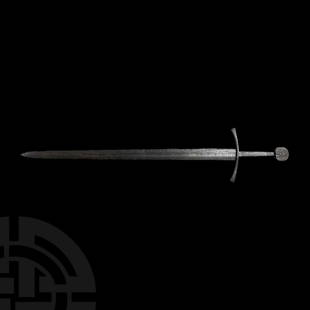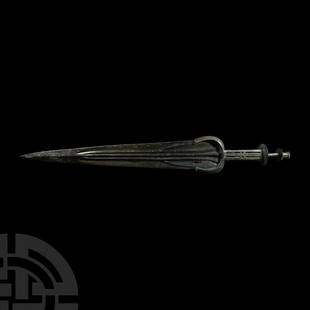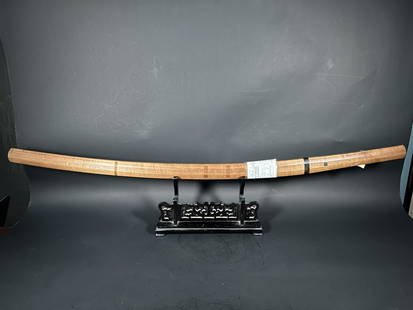

 Discovery- InteriorsBonhamsSponsored.Your ad here?
Discovery- InteriorsBonhamsSponsored.Your ad here?



Discovery- Interiors
Bonhams
Sponsored.Your ad here?


 Discovery- InteriorsBonhamsSponsored.Your ad here?
Discovery- InteriorsBonhamsSponsored.Your ad here?



Discovery- Interiors
Bonhams
Sponsored.Your ad here?

Single-Handed Double-Edged Sword with Inlaid S
Similar Sale History
View More Items in Weapons & ArmorRelated Weapons & Armor
More Items in Weapons & Armor
View MoreRecommended Collectibles
View More


Item Details
Description
Mid 11th-mid 12th century AD. A Western Middle Age double-edged iron sword, from Central Europe, of Petersen type X-Oakeshott type Xa, with tapered pattern-welded blade and narrow fullers, parallel-sided lower guard, long tang and 'tea-cosy' or mushroom-shaped pommel of B1 type; the pommel is in excellent state of preservation with some small areas of light pitting; the hilt is plain, widening towards the lower guard; the crossguard (Oakeshott style 1) is formed from a tapering bar of iron, crudely pierced to take the robust tang; the blade with inlaid S inside a circle; battle nicks to both sides, the blade showing signs of corrosion to the cutting edges; the tip of the blade absent. See Petersen, J., De Norske Vikingsverd, Oslo, 1919; Oakeshott, E.,The archaeology of weapons, arms and armour from the Prehistory to the Age of Chivalry, Woodbridge, 1960 (1999); Geibig A., Beiträge zur morphologischen Entwicklung des Schwertes im Mittelalter, Neumünster 1991; Aleksi?, M., Mediaeval Swords from Southeastern Europe, materials from 12th to 15th century, Beograd, 2007; a splendid example of this type in the Museum of Archaeology at Cambridge, its maker's name was Constaininus, which is inlaid in the bold straggling letters of the Viking Age, with the religious invocation similarly inlaid on the reverse (Oakeshott, 1960 (1999), p.204); the recent work of Dr. Aleksi? on the swords found in the territories of Southeastern Europe has put some light on the presence of such category of sword also found in the Balkans: a parallel with our sword is a specimen found in the river Sava near Bosanska Gradiška, northern Bosnia, today in the National Museum Bosnia and Herzegovina (inv. nr.6894), dated to the 11th century (Aleksi?, 2007, pl.9.1, cat.297); Aleksi?, who used the Oakeshott classification, noted as among the earlier specimens of swords of type X in the Eastern Europe prevailed the Type A pommels (Aleksi?, 2007, cat. nos. 55, 56, 297, 298, 349) in comparison to the Type B (Aleksi?, 2007, cat. nos.61, 299, 346) but among the later swords were much more frequent those with Type B pommels (Aleksi?, 2007, cat. nos.67, 84, 96, 131, 135, 182, 183, 228, 229, Pl. 13:1, 287, 295, 350, 346) in comparison to the type A (Aleksi?, 2007, cat. nos.16, pl.1:1 81?, 147, 288, 342, pl.11:1, 344?"). 631 grams, 76cm (30"). From an important private family collection of arms and armour; acquired on the European art market in the 1980s, and thence by descent; accompanied by an academic report by military specialist Dr Raffaele D'Amato. The sword's inlay allows the possibility to date it to the later period of the employment of this typology. The presence of inscriptions or symbols, like the letter S for SANCTVS (Saint), shows the definitive passage to the Christianity of the signs incised on the main chivalry weapon, the sword (gladius"). The work of Dr. Aleksi? points out a very important element, ie. the possibility that such swords were also produced in centres of the Eastern Europe. Moreover, in the territories of Balkans, there are specimens of type X with different pommels from those that are typical. For instance a sword from Slovakia (Aleksi?, 2007, cat.55) shows a blade of type X, and a pommel of type A. The inscription on this blade (INGEL(RII)) is the same as on two swords from Bosnia (the mentioned one, and a second one in Aleksi?, 2007, pl.9.2, cat.298"). All these swords, despite having considerably longer cross-guard should all be dated to the 11th century. The practice of mounting later pommels and cross-guards on the earlier blades could confuse in some cases when dating of such finds is concerned as it is the case, for instance, with the sword found in the Murtensee lake, near the mouth of river Broye, around twenty kilometers to the southwest of Bern (Aleksi?, 2007, Fig.20"). It has the blade of Type X and short hilt and cross-guard but also the pommel of Type Na (Aleksi?, 2007, p.23 and fig.1), which is at least a century later. The confusion in dating is also supported by other details, like the length or the width of the fullers. There are slender specimens, classified as type XIII from Geibig, with blades so conspicuously tapering towards the point that they would better correspond to the Oakeshott Type Xa. Usually, in such blades, the fuller is relatively long, around three quarters of the blade length and moderately wide (1.2-1.4cm").
Condition
Fine condition.
Buyer's Premium
- 30%
Single-Handed Double-Edged Sword with Inlaid S
Estimate £1,500 - £2,000
11 bidders are watching this item.
Shipping & Pickup Options
Item located in London, ukSee Policy for Shipping
Payment

TOP








































































![George Washington Signed Discharge: Partly printed discharge document signed by George Washington, as Commander in Chief of the Armies of the United States. Newburgh, [New York], 4 January 1783. 1 page, ## x ## in. Undersigned by Washin](https://p1.liveauctioneers.com/7226/322253/173251475_1_x.jpg?height=310&quality=70&version=1710004847)


